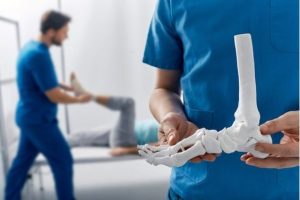
Nowadays, I’m here to examine the subject of foot deformations. You may be considering, “Isn’t that a befuddling point?” Well, it can be, but there’s a reason behind it. Numerous of us see having a distortion as a barricade in life. We feel self-conscious approximately talking about it, and we do not need individuals to stare at us, accepting it’s since of our deformation.
Whereas that could be incompletely genuine, we’re mixed up. Some time recently looking for endorsement from others, we got to grasp ourselves and what we’re managing with.
Ok! Let ask our sevles this:
How can we anticipate individuals to adore and acknowledge us when we haven’t indeed acknowledged ourselves? Numerous of us found arrangements to our issues since we chosen to talk up. Talking up can make a distinction, and you might fair conclusion up sparing somebody else within the handle. It’s not something to be embarrassed of.
Presently, let’s jump into the world of foot distortions
These conditions, differing and noteworthy, influence endless people around the world. They can be intrinsic, meaning show at birth, or procured due to wounds, sicknesses, or wear and tear over time.
Types of Foot Deformities
1) Bunions (Hallux Valgus): Bunions are characterized by the displacement of the big toe joint, causing the big toe to angle towards the other toes. This often results in a bony bump on the side of the foot.
2) Hammertoes: Hammertoes occur when one or more toes bend abnormally at the middle joint, resembling a hammer. This can lead to discomfort, corns, and calluses.
3) Claw Toes: Similar to hammertoes, claw toes involve abnormal bending of the toes, but they bend at multiple joints, causing the toes to resemble a claw-like shape.
4) Mallet Toes: Mallet toes are characterized by the abnormal bending of the joint at the end of the toes, causing them to curl downward.
5) Flat Feet (Pes Planus): Flat feet occur when the arches of the feet collapse, leading to the entire sole of the foot making contact with the ground. This can result in foot pain and instability.
6) High Arches (Pes Cavus): High arches involve an exaggerated arch in the foot, which can make the foot less flexible and lead to pain and instability.
7) Clubfoot: Clubfoot is a congenital deformity in which the foot is turned inward and downward. It usually requires early intervention and treatment.
8) Metatarsus Adductus: This condition is characterized by the front part of the foot turning inward. It is often seen in infants and may improve with time or require treatment.
9) Plantar Fasciitis: While not a structural deformity, plantar fasciitis involves inflammation of the plantar fascia, a thick band of tissue that runs along the bottom of the foot. It can cause heel pain and discomfort.
10) Cavus Foot: A cavus foot has a high arch, and the foot appears excessively curved. This can lead to instability and foot pain.
11) Tarsal Coalition: Tarsal coalition is a condition in which there is an abnormal connection between two or more tarsal bones in the foot, restricting movement and causing pain.
12) Accessory Navicular: This is an extra piece of bone or cartilage on the inner side of the foot, near the arch. It can be painful and may require treatment.
13) Polydactyly: Polydactyly is a congenital condition where a person is born with extra toes.
14) Brachymetatarsia: Brachymetatarsia is a condition where one of the metatarsal bones in the foot is shorter than the others, leading to a shortened toe.
15) Equinus: Equinus is a condition where the ankle joint is unable to flex properly, limiting the ability to point the toes upward.
16) Structural deformities: in a medical context, refer to abnormalities or irregularities in the shape, size, or alignment of bodily structures. These deformities can affect various parts of the body, including bones, joints, muscles, and organs. Structural deformities can be congenital, meaning they are present at birth, or they can develop later in life due to factors like injury, disease, or genetic mutations. These deformities can have a significant impact on an individual’s health and may require medical evaluation and treatment.
Examples of structural deformities include:
- Orthopedic Deformities: These involve abnormalities in the musculoskeletal system, such as:
- Bunions: A structural deformity of the foot where the big toe deviates inward, causing a bony bump on the side of the foot.
- Scoliosis: A sideways curvature of the spine, which can lead to an uneven shoulder or hip alignment.
- Hip Dysplasia: An abnormal development of the hip joint, which can result in hip instability and early arthritis.
- Cleft Lip and Palate: Structural deformities of the upper lip and roof of the mouth that occur during fetal development.
- Cardiac Deformities: These are structural abnormalities in the heart or its blood vessels, such as congenital heart defects.
- Craniofacial Deformities: These involve structural issues in the skull or face, including conditions like craniosynostosis (premature fusion of skull bones) or facial clefts.
- Genitourinary Deformities: Structural abnormalities in the reproductive and urinary systems, such as hypospadias (abnormal positioning of the urethra in males) or uterine malformations in females.
- Gastrointestinal Deformities: These include structural problems in the digestive system, such as esophageal atresia (a gap in the esophagus) or Hirschsprung’s disease (a missing section of the colon’s nerve cells).
- Neurological Deformities: Conditions like spina bifida involve structural abnormalities in the spine and nervous system.
- Dental and Facial Deformities: Conditions like malocclusion (improper alignment of teeth) or micrognathia (underdeveloped jaw) are examples.
- Skeletal Deformities: These can affect the bones and joints, resulting in conditions like clubfoot, brachydactyly (short fingers or toes), or polydactyly (extra fingers or toes).
17) Congenital deformities: often called birth defects, are structural or functional abnormalities present at birth. They can affect various body parts, including organs, limbs, and facial features, due to genetic, environmental, or unknown factors. These conditions can vary in severity and may require medical intervention to address their impact on health and development.
18) Neuromuscular deformities: Refer to structural abnormalities or functional impairments in the musculoskeletal system caused by underlying neurological conditions. These conditions affect the nerves, muscles, or their communication, leading to issues like muscle weakness, spasticity, or contractures. Management often involves physical therapy, assistive devices, and interventions to improve mobility and function.
19) Acquired deformities: They are structural or functional abnormalities that develop after birth, often due to factors like injury, disease, or trauma. These deformities can affect various body parts, including bones, joints, or soft tissues, leading to changes in appearance or impaired function. Treatment may involve surgical correction or rehabilitative therapies.
Facing Challenges
Foot deformities can cause pain, discomfort, and mobility issues. They can impact self-esteem and body image, leading to emotional struggles. Additionally, they may limit one’s participation in various activities.
Diagnosis and Treatment
Diagnosing foot deformities includes physical exams, restorative history audits, and conceivably imaging considers. Treatment alternatives change based on the sort and seriousness of the distortion and may incorporate:
- Physical Examination: A thorough physical examination is often the first step in diagnosing foot deformities. Healthcare providers assess the appearance, alignment, and functionality of the feet, toes, and ankles.
- Medical History: Gathering information about the patient’s medical history, including any family history of foot deformities, prior injuries, or surgeries, can provide important clues for diagnosis.
- Gait Analysis: Observing the patient’s walking or gait pattern can help identify abnormalities in foot function. This may involve walking on a pressure-sensitive mat or treadmill.
- Range of Motion Assessment: Evaluating the range of motion in the affected joints and comparing it to normal ranges can help determine the presence of deformities.
- Footwear Examination: Analyzing the patient’s footwear can provide insights into the impact of shoe choices on foot health and deformities.
- X-rays: X-rays are commonly used to visualize the bones and joints of the foot. They can help diagnose conditions such as bunions, fractures, arthritis, and structural abnormalities.
- Magnetic Resonance Imaging (MRI): MRI scans are used to assess soft tissue structures like tendons, ligaments, and muscles. They are particularly helpful in diagnosing conditions like plantar fasciitis or soft tissue tumors.
- Computed Tomography (CT) Scan: CT scans provide detailed images of bone structures and can be useful in diagnosing complex deformities or fractures.
- Ultrasound: Ultrasound imaging may be used to assess soft tissue abnormalities, such as tendon or ligament injuries.
- Blood Tests: In some cases, blood tests may be ordered to rule out systemic conditions that could contribute to foot deformities, such as rheumatoid arthritis or diabetes.
- Electrodiagnostic Tests: These tests, like nerve conduction studies and electromyography (EMG), may be used to evaluate nerve and muscle function in cases of neuropathic or neuromuscular foot deformities.
- 3D Foot Scanning: Advanced technology allows for the creation of three-dimensional scans of the feet, which can help in custom orthotic design and understanding the foot’s structure and pressure points.
- Arthroscopy: In certain situations, minimally invasive arthroscopy may be performed to directly visualize and diagnose joint conditions within the foot and ankle.
- Bone Density Testing: Dual-energy X-ray absorptiometry (DEXA) scans may be used to assess bone density, especially in cases related to osteoporosis or fractures.
Backing from healthcare experts, physical advisors, and orthopedic pros is fundamental. Keeping up great foot cleanliness and selecting appropriate footwear can make a critical distinction. Adaptive devices and mobility aids can enhance independence and quality of life.









